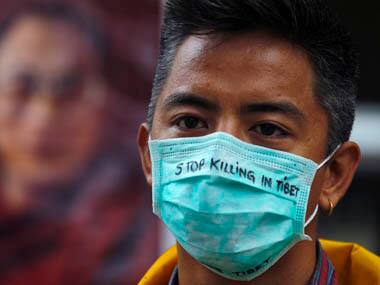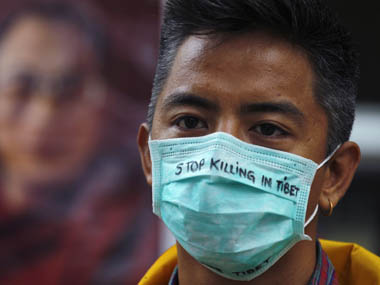As Prime Minister Narendra Modi concludes his visit to China pitching for pragmatic and purposeful Sino-Indian engagement, one community which normally hogs some limelight during such bilateral affairs is practically off the media radar. The debate over the issue of Tibetans living in India has been low-key this time around. While they are apprehensive that their concerns would be left unaddressed to avoid strain in relations New Delhi and Beijing, they still have high hopes from the Prime Minister’s visit. They had said it will be a meaningful visit for them only if the Indian Prime Minister “strongly raises the issue” of Tibet and brings it to the negotiation table. “Prime Minister Modi should hold a strong position and bring the issue of Tibet into discussion to raise our voice and concerns during his meeting with (Chinese President) Xi Jinping. There cannot be a lasting peace in the region without addressing the issue of Tibet. Tibet’s independence is the only way to ensure India’s security,” Dorjee Tseten, Asia director, Students for a Free Tibet, told Firstpost over phone from Dharamshala in Himachal Pradesh. [caption id=“attachment_2247844” align=“alignleft” width=“380” class=" “]  Reuters image.[/caption] He said Modi should not succumb to the Chinese pressure while inviting investments for India’s economic and trade development. “Dealing China with iron hand is something India needs at this juncture,” he had said and added, “China is not ready for signing Yarlung Tsangpo (Brahmaputra) river water treaty with India. Mega dam projects have been launched to divert the river’s water to Chinese main land to support industrialisation and mining. In addition to Tibet, it is a grave concern for India as well. If the river dries up, so does the future of millions of Indians dependent on its water for survival”. The activist had said PM Modi has the “chance to set the example for the rest of South Asia by standing up to China’s bullying, call them out on their gross human rights violations in Tibet and blatant stealing of Tibtan resources”. The activists have also written to the Prime Minister’s Office (PMO) and have lodged a campaign on social media to urge Modi to “stand up and save Tibet”. Gelek Namgyal, managing editor of Tebetan Review, had said, “We expect from Indian Prime Minister to press China to invite the Dalai Lama to negotiate and reach a permanent solution favourable to the Tibetan people. It is not only beneficial for India but also important for the security of Asia.” It is Tibet, not China, which has cultural as well as religious ties with India, he said and added that the Prime Minister should make the Chinese government realise the fact by highlight it. “While India is on side of the Himalayan range, Tibet is on the other. Both Mount Kailash and Manasarovar lake culturally belong to both Tibet and India. They are as sacred for the Buddhists in the Land of Snows as for Hindus back here who consider the place as the abode of Lord Shiva. Therefore, whatever is happening on one side will always affect the other side as well. The cultural relations between India and Tibet are something which will continue to exist forever,” he told Firstpost. He had urged Prime Minister Modi to hold discussion on MacMahon Line, which was agreed as part of the Simla accord in 1914. China rejects the accord, contending that the Tibetan government was not sovereign and therefore did not have the power to conclude treaties. Chinese maps show some 65,000 square kilometres of the territory south of the line as part of the Tibet Autonomous Region, known as South Tibet in China. Ugen Chokdp, who is pursuing M.Phil in Chinese language from Jawaharlal Nehru University, was hopeful that PM Modi’s ongoing visit will bring about some change in Chinese stand on Tibet but at the same he also fears that amid hullaballoo, the Tibetan cause is left behind. “We are optimistic enough that Mr Modi’s visit will result into solutions to the Tibtan people’s concerns. But at the same time, we have a traditional anxiety that the issue is not left behind as witnessed in the past. Tibet is under heavy militarisation and unless it is removed, the dispute will never get resolved. For me, demilitarisation of the region is important for any negotiation or dialogue to succeed,” he had said. Some also requests the Indian government not to legitimise Chinese “forceful occupation” of Tibet like his party’s predecessor Atal Bihari Vajpayee who had said in February 1979 during his visit to China that “the Indian side recognises that the Tibet Autonomous Region is an integral part of the People’s Republic of China”. “To add insult to the injury, the same statement was repeated in May 2008 by the then External Affairs Minister Pranab Mukherjee. If you cannot resolve the issue, please keep mum. Please do not make such statements. It hurts our sentiments,” Lobsang Chonden, who lives in Tibtan refugee colony at Majnu-ka-Tila in the national capital and is involved in the equity market for years. For him, this is not much meaningful visit for Tibtan community living in India. “I personally do not have any expectation from PM Modi’s visit because he will never raise such a controversial issue that can strain the relations between the two nations,” he had said.
As Prime Minister Narendra Modi concludes his visit to China pitching for pragmatic and purposeful Sino-Indian engagement, one community which normally hogs some limelight during such bilateral affairs is practically off the media radar.
Advertisement
End of Article


)

)
)
)
)
)
)
)
)



